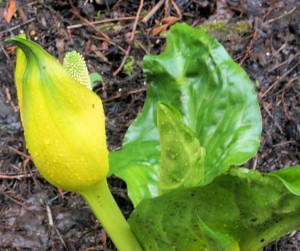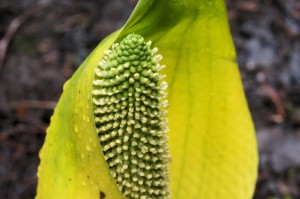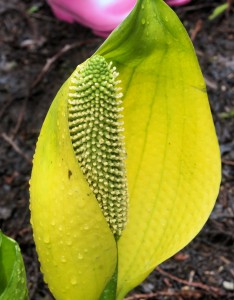
Along the path in the Nature Discovery area of the Bellevue Botanical Garden in the wet areas next to a pond, we spotted some American Skunk Cabbage (Lysichiton americanus Hultén & H. St. John). This member of the Arum Family (Araceae) naturally grows In Alaska, British Columbia, Washington, Idaho, Montana, Wyoming and California. It locally common next to streams and other wet areas. The plant was introduced to Britain and Ireland in 1901 and has escaped and become naturalized in several areas.
In Washington State, it is found in virtually every county west of the Cascade Crest and in the three Northeastern counties of the state.
The whole plant is foul smelling. The odor permeates the whole area where the colonies are found, and can be detected in old dried botanical specimens.
The leaves appear at flowering and are egg-shaped and deep-green. Typically, they are between 1 and 2 feet long, and about half as wide as long. The flowers use the smell to attract pollinators. They are yellow-green and numerous attached to a spike, called a spadix, which is surrounded by a large bract, called a spathe.
Interestingly, the root are what is called contractile. This means that as the plant grows, the roots pull the crown of the plant deeper into the mucky soil. It is claimed that this characteristic has allow some individual plants to remain in an area for hundreds of years as long as the soil does not completely dry out.
Native Americans used the plant as a medicine for burns and injuries as well as a food in times of famine. The plant is said to have a peppery taste. Due to the high calcium oxalate content, care should be taken in preparation for human consumption.





